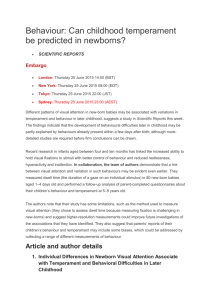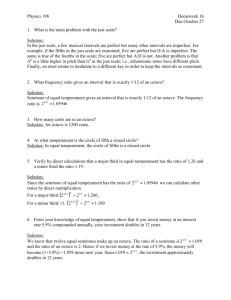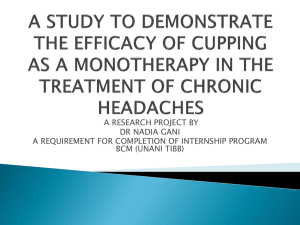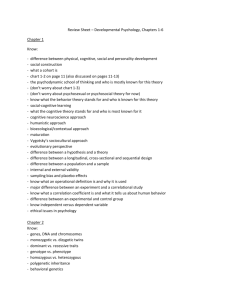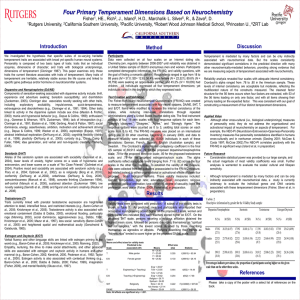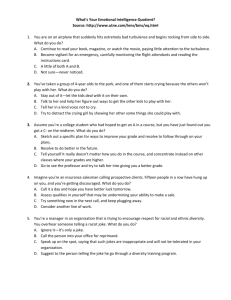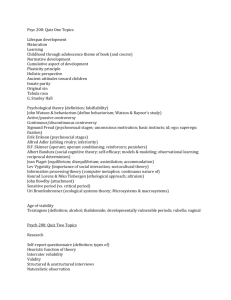DOC - Commonwealth Association for Education Administrator
advertisement
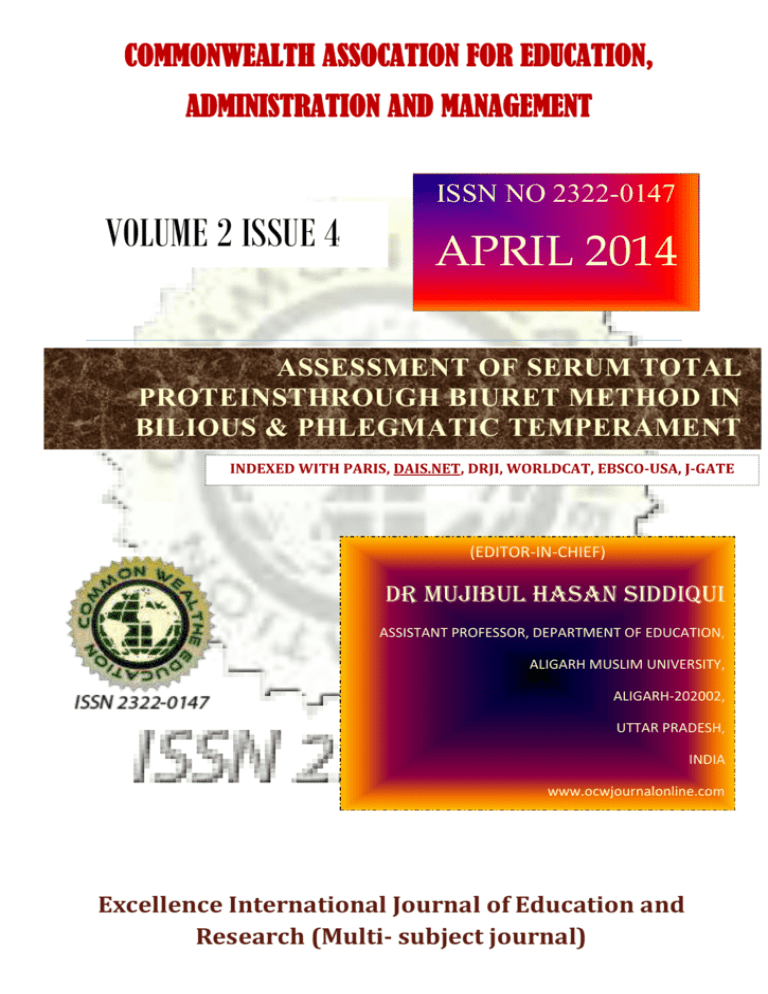
COMMONWEALTH ASSOCATION FOR EDUCATION, ADMINISTRATION AND MANAGEMENT VOLUME 2 ISSUE 4 ISSN NO 2322-0147 APRIL 2014 ASSESSMENT OF SERUM TOTAL PROTEINSTHROUGH BIURET METHOD IN BILIOUS & PHLEGMATIC TEMPERAMENT INDEXED WITH PARIS, DAIS.NET, DRJI, WORLDCAT, EBSCO-USA, J-GATE (EDITOR-IN-CHIEF) DR MUJIBUL HASAN SIDDIQUI ASSISTANT PROFESSOR, DEPARTMENT OF EDUCATION, ALIGARH MUSLIM UNIVERSITY, ALIGARH-202002, UTTAR PRADESH, INDIA www.ocwjournalonline.com website: www.ocwjournalonline.com Excellence International Journal of Education and Research (Multi- subject journal) Excellence International Journal Of Education And Research VOLUME 2 ISSUE 4 ISSN 2322-0147 ASSESSMENT OF SERUM TOTAL PROTEINSTHROUGH BIURET METHOD IN BILIOUS & PHLEGMATIC TEMPERAMENT By S M Ahmer PG Scholar Department of Kulliyat Faculty of Unani Medicine A.M.U Aligarh E- mail: drsmahmer@yahoo.com Dr. Ferasat ali Associate Professor Department of Kulliyat Faculty of Unani Medicine A.M.U Aligarh ABSTRACT The objectives of this study is to assess the value of total serum protein in bilious and phlegmatic temperament individuals through Biuret Method, and to analyze whether serum total protein levels in Bilious and Phlegmatic temperament (Mizaj) are similar or dissimilar within normal healthy state.The mean and standard deviation of total serum protein levels of bilious and phlegmatic subjects were calculated. It was revealed after this study that the mean total serum protein of bilious subjects was 7.51 (g/dl) with standard deviation of 0.83 while the mean total serum protein of phlegmatic subjects was 7.05 (g/dl) with standard deviation of 0.63. In this way it can be said that the average total serum protein of the healthy bilious subject is higher than that of a phlegmatic subject. The T-test was applied to test the significance of the results and it was found that the difference of total serum protein level of bilious and phlegmatic subjects was highly significant (p<0.001). Keywords: Temperament (Mizaj), humor, bilious, phlegmatic, and serum total protein. INTRODUCTION: Research on the human serum proteins has been directed towards problems of physiological and biochemical interest as well as towards those of medical and genetical interest. From the physiological and biochemical point of view, the serum proteins play important roles as biological buffer systems, in the maintenance of the osmotic pressure of the blood, control of blood pH, transport of lipids, dietary nitrogen, and other inorganic elements, and in immunological and other functions. Protein is a proximate principle (Awamil-e-Qaribah) of the body because protein is an essential substance of humors (Akhlat). Proteins are essential parts of organisms and participate in virtually every process within cells. Proteins are the essential substances of which the protoplasm of the cells and the intracellular substances are built. Proteins form the fundamental basis of the structure and function of life. [1] Temperament is an empirical expression describing the humoral composition that regulates the physiological and pathological changes in the human body. Thus, there are no two individuals are same in their temperament. So each individual due his specific Temperament is said to possess certain innate strength and deficiencies, for which he reacts differently to given set of environmental conditions. The temperament is formed Excellence International Journal Of Education And Research (Multi-subject journal) Page 584 Excellence International Journal Of Education And Research VOLUME 2 ISSUE 4 ISSN 2322-0147 by interaction of opposite qualities present in the elements (Arkan). These qualities are primary four in number, namely hotness, coldness, moistness, and dryness. Thus, Unani physicians broadly classified the people into four types of Temperament either on the basis of humors. These four types of Mizaj (Temperament) are: 1).HOT & MOIST: DAMVI MIZAJ (SANGUINEOUS) 2). COLD & MOIST: BALGHAMI MIZAJ (PHLEGMATIC) 3). HOT & DRY: SAFRAVI MIZAJ (BILIOUS) 4). COLD & DRY: SAUDAVI MIZAJ (MELANCHOLIC) [2 ] The Hippocrates (460-370BC) gave the fundamental principles of Greco-Arab System of Medicine with a belief that the body of the individual is composed of four basic elements, which together, are termed as ‘Anasir-e-Arba’ or Arkan’(Elements) comprising earth, water, air and fire as different states of matter and the building blocks of everything in the universe. These four basic elements possess four different qualities, i.e. hot, cold, dry and wet. The admixture of these four basic elements results in the formation of four biological fluids or Humors viz. Blood (Dam), Phlegm (Balgham), Bile (Safra) and Black bile (Sauda); a right proportion, according to quality and quantity constitutes health and upright proportion and irregular distribution, according to their quantity and quality constitutes disease. Thus the basic principle of GreecoArabic Medicine is that the four humors represented in the human blood.[3] The Literal Meaning of Temperament (Mizaj): The literal meaning of mizajaccording to Nafis is “Intermixture” as he says “The word mizaj originated from Arabic word imtizaj meaning intermixture ”.[4] Mizaj is derived from Arabic word “mzj” which means mixing of humors. At other places it is described that mizaj refers to the intermixture of four humors within human body, it is the basis of body. (Lisan-ul-Arab) The literal meaning of the word “temperament” as given in few authentic dictionaries are as follows: [5] Temperament – combination or predominance of humours. (Chamber dictionary) Temperament is constitutionally based individual differences in emotion, attention, activity level and self-regulation. (New Concise Medical Dictionary) Temperament – the combination of intellectual, emotional, ethical a nd physical characteristics of an individual. (Taber’s encyclopedia medical dictionary) Temperament – the physical organization peculiar to the individual, which influences one’s metabolic process, manner of thought and action and the general view of life. (Stedman). Temperament is defined as that part of the personality, which is genetical ly based. Along with character and those aspects that are acquired through learning, the two together are said to constitute personality. [6] Definition of Mizaj:Galen(130-200 AD)says that: “Temperament is a quality produced by action and reaction of opposite qualities of body fluids (Akhlat). When these components interact by virtue of their respective powers (qualities) a condition is achieved which is found in equal proportions in all the components of that intermixture; this is called temperament”.[7] IbnSina(980-1037 AD) in his famous book “Al-Qanoon-fil-Tib”says:“The temperament is a quality resulting from the interaction of opposite qualities present in elements consisting of minute particles so that most of the particles of each of the elements may touch most of the others. Thus when these particles act and react on one another with their properties, there emerges from their total properties, a uniform quality which is present in all of them. This is the temperament (Mizaj)” [8] Similarly the normal temperament of an individual is defined as “a condition in which he survives comfortably with all systems of healthy life”, which varies widely as per composition and as well as other surrounding factors and circumstances in which he resides. [9] Excellence International Journal Of Education And Research (Multi-subject journal) Page 584 Excellence International Journal Of Education And Research VOLUME 2 ISSUE 4 ISSN 2322-0147 Therefore, in this universe all animates or inanimate, however alike in origin and structure does not resemble one another perfectly. The Temperament fluctuates in particular normal range of maximum and minimum limits. Whenever it crosses its normal limit, it leads to the abnormality (Su-e-Mizaj) within the body.[10] Characteristic of Safravi Mizaj (Bilious Temperament) Individuals Humor: Yellow Bile Basic Qualities: Hot and Dry (Haar&Yabis). The Bilious temperament is the hottest, most active and catabolic of all. Physique: Compact, lean, moderately muscular and less fatty, Good muscle tone. Prominent veins and tendons. Broad chest common. An active, sportive type. Weight gain usually in chest, arms, belly, upper body. Hair: Often thick and curly texture, black in color and rapid profuse growth.Balding common in men. Complexion: yellowish, reddish color if heat predominates; sallow or bright yellow if bile predominates. Rough and dry, quite warm. Appetite: Sharp and quick. Soon overcome by ravenous hunger. Fond of meat, fried foods, salty or spicy foods, alcohol, intense or stimulating taste sensations. Digestion: Sharp and quick. Tendency towards gastritis, hyperacidity, acid reflux. When balanced and healthy, can have a "cast iron stomach", able to digest anything. Metabolism: Strong, fast, active; catabolic dominant. Strong Innate Heat of metabolism. Liver and bile metabolism can be problematic. Digestive secretions strong, bowel transit time short. Adrenals, sympathetic nervous system dominant. Strong inflammatory reactions. Predispositions: Fevers, infections, inflammation. Hives, rashes. Fatty liver, bilious conditions. Hyperacidity, acid reflux, inflammatory and ulcerative conditions of middle GI tract. Headaches, migraines, irritability. Eyestrain, red sore eyes. High cholesterol, cardiovascular disorders. Bleeding disorders from excess heat. Hypertension, stress disorders. Urine: Tends to be scanty, yellowish dark, and thin. Can be hot or burning. Stool: Tends towards diarrhea, loose stools. Can have a yellowish color, foul odor. Sweat: Profuse, especially in summer, or with vigorous physical activity. Strong body odor. Sensitive to hot weather, suffers greatly in summer. Sleep: Often fitful, restless, disturbed, especially with stress, indigestion. Often tends to wake up early, or in the middle of the night. Dreams: Often of a military or violent nature. Dreams of fire, yellow things common. Fight or flight, confrontation. Mind: Bold, daring, original, imaginative, visionary. Ideation faculty well-developed. Brilliant intellect, sharp penetrating insight. The idea man who prefers to leave the details to others. Personality: Prone to anger, impatience, irritability; short temper. Bold, courageous, audacious; confrontive, contentious. Dramatic, bombastic manner; high powered personality. The rugged individualist and pioneer; thrives on challenge. The fearless leader. Seeks exhilaration, intense experiences. Characteristic of Balghami Mizaj (Phlegmatic Temperament) Individuals: Humor: Phlegm (Balgham) Basic Qualities: Cold and Wet (Barid&Ratab) The Phlegmatic temperament is the coldest, most passive, energy conserving and anabolic. Physique: Heavy frame, fatty and flabby, with flesh ample and well-developed. Often pudgy, plump or overweight; obesity common. Joints dimpled, not prominent. Veins not prominent, but can be bluish and visible. Lax muscle tone common. Feet and ankles often puffy, swollen. Weight gain especially in lower body. Flat chest. Hair: Thin and straight, slow scanty growth and distribution, brownish,light colored, blondish hair common. Complexion: Pale, pallid complexion; very fair. Soft, delicate, cool moist skin. Cool, clammy perspiration common, especially in hands and feet. Excellence International Journal Of Education And Research (Multi-subject journal) Page 585 Excellence International Journal Of Education And Research VOLUME 2 ISSUE 4 ISSN 2322-0147 Appetite: Slow but steady. Craves sweets, dairy products, starchy glutinous foods. Digestion: Slow but steady to sluggish. Gastric or digestive atony common. Sleepiness, drowsiness after meals common. Metabolism: Cold, wet and slow. Conserves energy, favors anabolic metabolism. Congestion, poor circulation, especially in veins and lymphatics. Adrenals and thyroid tend towards hypofunction; basal metabolic rate low. Metabolic Water drowning out metabolic Fire. Predispositions: Phlegm congestion. Water retention, edema. Lymphatic congestion, obstruction. Poor venous circulation. Gastric atony, slow digestion. Hypothyroid, myxedema. Adrenal hypofunction. Weight gain, obesity. Frequent colds and flu. Chronic respiratory conditions, congestion. Swollen legs, ankles, feet. Poor tone of skin, muscles. Urine: Tends to be clear/pale and thick. Tends to be scanty in volume, with excess fluid accumulation in the body. Stool: Well-formed, but tends to be slightly loose, soft. Bowels tend to be sluggish. Sweat: Cool, clammy sweat common, especially on hands and feet. Sweating can be easy and profuse. Sensitive to cold weather; suffers greatly in winter. Sleep: Very deep and sound. Tends towards excessive sleep, somnolence. Snoring common; can be loud or excessive. Dreams: Generally very languid, placid. Water and aquatic themes common. Mind: Tends to be dull, foggy, slow. Slow to learn, but once learned, excellent and long retention. Patient, devoted, faithful. Faculty of Empathy well-developed. Sentimental, subjective thinking. A calm, good-natured, benevolent mental outlook. Personality: Good natured, benevolent, kind. Nurturing, compassionate, sympathetic. Great faith, patience, devotion; tends to be religious, spiritual. Sensitive, sentimental, emotional, empathetic. Passive, slow, sluggish; averse to exertion or exercise. Calm, relaxed, takes life easy. Excessive sluggishness, torpor can lead to depression.[11, 12, 13] PURPOSE OF THE STUDY: The present study has been attempted with two different categories Bilious and Phlegmatic temperament individuals because these two categories show different types of signs and symptoms as their physiological, physical, and psychological features and are opposite to each other on the basis of their Hot and Cold temperament respectively. Basically these two main states of hotness and coldness play vital role in determination of temperament. The study was started with following aims and objectives. 1) To assess the value of total serum protein in Bilious and phlegmatic temperament through Biuret Method. 2) To analyze whether total serum protein levels in Bilious and Phlegmatic temperament are similar or dissimilar within normal healthy state. HYPOTHESES OF THE STUDY: Total serum protein would be relatively higher in Bilious than Phlegmatic temperaments because as per Unani literature, The Bilious individuals are energetic and hyperactive than phlegmatic individuals, they have excellent metabolism activities, hence they have physiologically higher level of total protein because liver plays an important role in metabolism and the metabolic rate of Safravi individuals are rapid than Balghami, therefore the level of total protein should be higher in Safravi than Balghami individuals. In comparison to Safravi, Balghami individuals are flaccid and obese body built with soft and flabby muscles and they possess more fat in their body. Fat always denotes coldness. But Safravi individuals are lean and thin they possess very little fat shows that the temperament is hot and dry.[8] METHOD OF THE STUDY:Selection of volunteers, Sample Size, and Inclusion criteria: This study was carried out in PG Lab, Department of Kulliyat, Ajmal Khan Tibbiya College, Aligarh Muslim University, Aligarh, during the period from 2010 -2013. Volunteers were selected randomly from students of the Ajmal Khan Tibbiya College and Excellence International Journal Of Education And Research (Multi-subject journal) Page 586 Excellence International Journal Of Education And Research VOLUME 2 ISSUE 4 ISSN 2322-0147 some other faculties of Aligarh Muslim University and Aligarh city, preference was given to students residing in hostels because their environment and nutritional status remain almost static and constant. One hundred ten (110) male volunteers in the age group of 20–35 years, having Bilious (Safravi) and Phlegmatic (Balghami) temperament were selected for the study. The reason for selecting this age group is that the volunteers in this age group are mostly healthy and disease free. Exclusion Criteria: Female volunteers and volunteers below 18years and above 35 years were excluded,the persons of Melancholic and Sanguine temperament were excluded from the study,the persons of the athletic activities, heavy exercise and gymnastics were excluded from the study, thevolunteers having a history of Radiotherapy, Chemotherapy, major accident and surgery or taking steroids for long periods were excluded from this study andthe volunteers, suffering from Malnutrition, Diabetes Mellitus, Poliomyelitis, Tuberculosis, Hyperthyroidism , Hypothyroidism or any other chronic diseases, were excluded from the study. For the selection of healthy volunteers, detailed clinical history, physical, general and local examinations were done. Determination of Temperament: The assessment of temperament (Mizaj) of the volunteers was made on the basis of Ajnas-e-Ashra (ten determinants), mentioned in classical Unani literature. Categorization of individual: After determination of the temperament, selected volunteers were divided into two groups according to their temperament. Group A: Bilious temperament (Safravi Mizaj) Group B: Phlegmatic temperament (BalghamiMizaj) After determination of Bilious and Phlegmatic temperament, the volunteers were randomly called for venipuncture. All volunteers were advised to remain at fast overnight before their blood samples were drawn. The blood specimens were allowed to clot at room temperature and then centrifuged within an hour of venipuncture. The sera obtained were assayed within two hours of venipuncture. ESTIMATION OF TOTAL PROTEIN: BIURETE METHOD was adopted in order to estimate the total serum protein. The most widely used method of measuring serum protein is the Biuret Reaction. ThePrinciple of this reaction is that Peptide bonds of protein form a blue-violate colored complex with cupric ions an alkaline medium. The intensity of the color is proportional to the number of peptide bonds and the color is read at 546 nm (530-570 nm). Total protein + Biuret reagent ----->purple colored Cu-peptide bond complex (alkalineCu++) Reagents: (They were supplied by Siemens ltd) Normal Values: Total Serum Protein: 6.6-8.3 g/dl.[14] OBSERVATIONS & RESULTS: Table–01: Showing Distribution of Volunteers according to the Temperament Temperament Frequency Percentage Bilious 65 59.10 Phlegmatic 45 40.90 Total 110 100 Graph-01: Showing Distribution of Volunteers according to the Temperament Excellence International Journal Of Education And Research (Multi-subject journal) Page 587 Excellence International Journal Of Education And Research VOLUME 2 ISSUE 4 ISSN 2322-0147 Frequency Choleric, 65 Choleric Phlegmatic Total Total, 110 Phlegmatic, 45 Out of 110 volunteers, 65 were Bilious temperament and 45 Phlegmatic temperaments and their percentage of 59.10% & 40.90% respectively as displayed in Table -01and Graph. 01. Table-02:Indicating Total Serum Protein of volunteers expressed as Mean ± SD* Temperament Number of Volunteers Mean ± SD* Bilious 65 7.51 ± 0.83 Phlegmatic 45 7.05 ± 0.63 Total 110 Graph-02: Indicating Mean Difference of Total Serum Protein in different Temperaments Choleric 80 Phlegmatic 65 60 45 40 20 7.51 7.05 0 Number of Volunteers Mean The mean and standard deviation of total serum protein levels of bilious (Safravi) and phlegmatic (Balghami) subjects were calculated. It was revealed after this study that the mean total serum protein of bilious (Safravi) subjects was 7.51 (g/dl) with standard deviation of 0.83 while the mean total serum protein of phlegmatic (Balghami) subjects was 7.05 (g/dl) with standard deviation of 0.63. In this way it can be said that the average total serum protein of the healthy bilious subject is higher than that of a phlegmatic subject. (Table-02, Graph-02) Table-03:Showing Characteristics of Volunteers Expressed As Mean ± SD Temperaments Safravi Balghami Excellence International Journal Of Education And Research (Multi-subject journal) Page 588 Excellence International Journal Of Education And Research VOLUME 2 ISSUE 4 No. of Subjects 65 45 Age (Mean ± SD) Heigh(Mean ± SD) Weight (Mean ± SD) 25.2±2.5 169.69±4.4 60.12±5.8 27.8±3.0 168.68±3.08 67.75±5.6 TP (Mean ± SD) 7.51±0.83 7.05±0.63 ISSN 2322-0147 SD: Standard deviation. The mean and standard deviation of age, height, weight, and total protein of bilious and phlegmatic temperaments subjects were calculated. It was revealed after this study that the mean of age, height, weight and total protein of bilious subjects was 25.2 (years), 169.69 (cm), 60.12 (kg), and 7.51 (g/dl) with standard deviation of 2.5, 4.4, 5.8, and 0.83 respectively, while the mean of age, height, weight and total protein of phlegmatic subjects was 27.8 (years), 168.68 (cm), 67.75 (kg) and 7.05 (g/dl) with standard deviation 3.0, 3.08, 5.6 and 0.63 respectively, as shown in table 03. Graph-03: Showing Total Serum Protein of Volunteer Safravi 10 Balghami TOTAL PROTEIN 8 6 4 2 0 1 4 7 10 13 16 19 22 25 28 31 34 37 40 43 46 49 52 55 58 61 64 NO OF VOLUNTEERS Total serum protein was higher in bilious volunteers as compared to phlegmatic volunteers and the difference was statistically significant as shown in the graph-03. Table-03: Showing the Results in Volunteers according to their Temperament Parameters Mizaj Number of Volunteers Mean ± S.D Bilious 65 7.51±0.83 Significance P<0.001 Total Serum Protein Phlegmatic 45 7.05±0.63 Significant at the level of p<. 05 Present study after statistical analysis showed that the difference of total serum protein level of bilious and phlegmatic temperament subjects was highly significant as shown in Table 03. In this study of 110 volunteers, we have observed that a relation can be established in between Total Serum Protein and temperament. The level of total serum protein was higher in the bilious temperament volunteers as compared to volunteers of phlegmatic temperament. Excellence International Journal Of Education And Research (Multi-subject journal) Page 589 Excellence International Journal Of Education And Research VOLUME 2 ISSUE 4 ISSN 2322-0147 Result: The mean and standard deviation of total serum protein levels of bilious and phlegmatic subjects were calculated. It was revealed after this study that the mean total serum protein of bilious subjects was 7.51 (g/dl) with standard deviation of 0.83 while the mean total serum protein of phlegmatic subjects was 7.05 (g/dl) with standard deviation of 0.63. In this way it can be said that the average total serum protein of the healthy bilious subject is higher than that of a phlegmatic subject. The T-test was applied to test the significance of the results and it was found that the difference of total serum protein level of bilious (Safravi) and Phlegmatic (Balghami) subjects was highly significant (p<0.001). CONCLUSION: From the findings of this study following conclusion can be drawn. The individuals having bilious (Safravi) temperament have higher levels of total protein than the phlegmatic (Balghami) individuals. Thus a relationship can be established between the temperament and blood protein which validates the Unani claims that The bilious (Safravi) individuals are energetic and hyperactive than phlegmatic individuals, they have excellent metabolism activities, hence they have physiologically higher level of total protein because liver plays an important role in metabolism and the metabolic rate of Safravi individuals are rapid than Balghami, therefore the level of total protein should be higher in Safravi than Balghami individuals. In comparison to Safravi, Balghami individuals are flaccid and obese, they possess more fat in their body as compared to protein. Fat always denotes cold temperament. But Safravi individuals are lean and thin they possess very little fat shows that the temperament is hot and dry. In our study, it is clearly evident that temperament of an individual is influenced by his blood composition and its constituents. Therefore, the blood compositions play an important role in creation of temperament of an individual. The results show that there does exist a relationship between blood protein and the temperament of an individual. The need of the hour is to understand the concept & importance of temperament (Mizaj) and its application in Unani as well as other health care. REFERENCES 1. David L.Nelson, Michael.M.Cox (2004) “Lehninger Principles Of Biochemistry”, 3rd Edition, Maemillan Worth Publishers, New York,Pp-22, 23,1020, 1021. 2. 3. Ahmad S.I, (1980), “Al Umoor Al Tabiyah”, Ist Edition, Saini Printers, New Delhi, pp. 53-63. Journal of Integrated Community Health, Volume-1, Issue-1, January-June (2012), Published by Department of TahaffuziwaSamajiTib, Faculty of Unani Medicine, AMU, Aligarh, pp-9, 10,11. Nafis B, (1910),Sharah Al Maujiz, Part I translation and elaboration, MatbaYusufi, Lucknow, pp. 17. Arshad K (2009), “A Study to Evaluate Variations in Total Skeletal Muscle Mass in Phlegmatic and Bilious Temperaments” Thesis Submitted in PG department of Kulliyat, f/o Unani Medicine, AMU, Aligarh, pp-9,10. Shah M.H, (1972),Temperament, Explanation and Interpretation Philosophy of medicine and Science Problems and perspective, compiled by Department of Philosophy of Medicine and Science, IHMMR New Delhi, pp.123-128, 109-111. Galen, KitabFilAnasir,( 2008), Edited and Translated by ZillurRehman, International Printing Press, Aligarh, pp. 99-100. IbnSina, (1993), “Al QanoonfilTibb”, Book-I, English translation of the critical Arabic Text, JamiaHamdard, New Delhi, pp. 7-13,65, 190-197. 4. 5. 6. 7. 8. 9. Zaidi I.H and Zulkifle M, (1999), Temperamentlogy A Scientific Appraisal of Human Temperament,1stEdition,Aligarh, pp.6-8, 21-23, 34. 10. Ferasat Ali (2005), ‘Mizaj-e-InsaniAqlimiTanazur Main’ Universal Book House, Aligarh, pp-20, 21, 35, 52. Excellence International Journal Of Education And Research (Multi-subject journal) Page 590 Excellence International Journal Of Education And Research 11. 12. 13. 14. VOLUME 2 ISSUE 4 ISSN 2322-0147 Gruner O.C, (1930) “A Treatise on the Cannon of Medicine of Avicenna”, Luzac& Co. London, pp. 57, 264, 273. Mansoor Bin Mohd Yusuf Bin Ahmad Bin Iliyas (1915), “ KefayaMansoori” Urdu Translation by HkmHadi Husain Khan, MatbaMunshi Naval Kishore, Kanpur, pp-66, 67. Kabiruddin M, (1954), “TarjumawaSharah Kulliyat-e-Nafisi”, Part-II, MatbaDaftarulMasihi, Hyderabad, pp-266-280. Henry, R.J.D.C, Winkelman, J.W. (1974) “Clinical Chemistry Principles and Technics”, Harper and Row 2nd Edition. Excellence International Journal Of Education And Research (Multi-subject journal) Page 591
